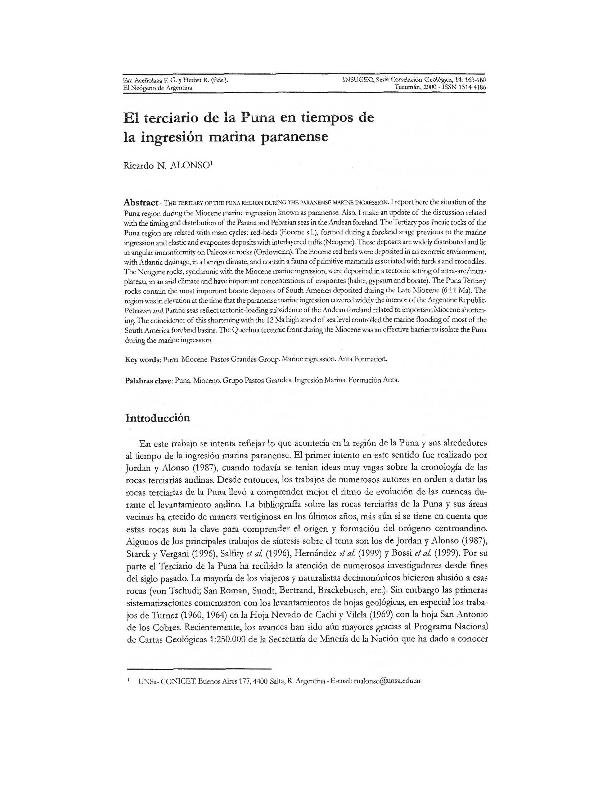Mostrar el registro sencillo del ítem
dc.contributor.author
Alonso, Ricardo Narciso

dc.date.available
2021-03-29T16:09:01Z
dc.date.issued
2000-12
dc.identifier.citation
Alonso, Ricardo Narciso; El Terciario de la Puna en tiempos de la ingresión marina paranense; Instituto Superior de Correlación Geológica. Centro Argentino de Información Científica y Tecnológica; Serie Correlación Geológica; 14; 12-2000; 163-180
dc.identifier.issn
1514-4186
dc.identifier.uri
http://hdl.handle.net/11336/129153
dc.description.abstract
I report here the situation of the Puna region during the Miocene marine ingression known as paranense. Also, I make an update of the discussion related with the timing and distribution of the Parana and Pebasian seas in the Andean foreland. The Tertiary pos-Incaic rocks of the Puna region are related with main cycles: red-beds (Eocene s.l.), formed during a foreland stage previous to the marine ingression and clastic and evaporites deposits with interlayered tuffs (Neogene). These deposits are widely distributed and lie in angular unconformity on Paleozoic rocks (Ordovician). The Eocene red beds were deposited in an exorreic environment, with Atlantic drainage, in a benign climate, and contain a fauna of primitive mammals associated with turtles and crocodiles. The Neogene rocks, synchronic with the Miocene marine ingression, were deposited in a tectonic setting of intra-arc/intra-plateau, in an arid climate and have important concentrations of evaporites (halite, gypsum and borate). The Puna Tertiary rocks contain the most important borate deposits of South America deposited during the Late Miocene (6±1 Ma). The region was in elevation at the time that the paranense marine ingression covered widely the interior of the Argentine Republic. Pebasian and Parana seas reflect tectonic-loading subsidence of the Andean foreland related to important Miocene shortening. The coincidence of this shortening with the 12 Ma high stand of sea level controlled the marine flooding of most of the South America foreland basins. The Quechua tectonic front during the Miocene was an effective barrier to isolate the Puna during the marine ingression.
dc.format
application/pdf
dc.language.iso
spa
dc.publisher
Instituto Superior de Correlación Geológica. Centro Argentino de Información Científica y Tecnológica
dc.rights
info:eu-repo/semantics/openAccess
dc.rights.uri
https://creativecommons.org/licenses/by-nc-sa/2.5/ar/
dc.subject
TERCIARIO
dc.subject
PUNA
dc.subject
INGRESION MARINA
dc.subject
PARANENSE
dc.subject
MIOCENO
dc.subject
FORMACION ANTA
dc.subject
GRUPO PASTOS GRANDES
dc.subject.classification
Geología

dc.subject.classification
Ciencias de la Tierra y relacionadas con el Medio Ambiente

dc.subject.classification
CIENCIAS NATURALES Y EXACTAS

dc.title
El Terciario de la Puna en tiempos de la ingresión marina paranense
dc.title
The tertiary of the Puna region during the paranense marine ingression
dc.type
info:eu-repo/semantics/article
dc.type
info:ar-repo/semantics/artículo
dc.type
info:eu-repo/semantics/publishedVersion
dc.date.updated
2021-03-15T14:41:20Z
dc.identifier.eissn
1666-9479
dc.journal.volume
14
dc.journal.pagination
163-180
dc.journal.pais
Argentina

dc.journal.ciudad
Tucumán
dc.description.fil
Fil: Alonso, Ricardo Narciso. Universidad Nacional de Salta; Argentina. Consejo Nacional de Investigaciones Científicas y Técnicas. Centro Científico Tecnológico Conicet - Salta; Argentina
dc.journal.title
Serie Correlación Geológica
dc.relation.alternativeid
info:eu-repo/semantics/altIdentifier/url/http://www.insugeo.org.ar/publicaciones/docs/scg_14/11_terciario_de_la_puna.htm
Archivos asociados
